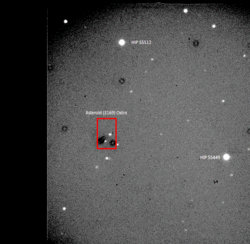3169 Ostro
Appearance
 3169 Ostro imaged by the 0.7-m telescope at Heidelberg Observatory | |
| Discovery [1] | |
|---|---|
| Discovered by | E. Bowell |
| Discovery site | Anderson Mesa Station |
| Discovery date | 4 June 1981 |
| Designations | |
| 3169 Ostro | |
Named after | Steven J. Ostro[2] |
| 1981 LA | |
| main-belt (inner) | |
| Orbital characteristics [1] | |
| Epoch 13 January 2016 (JD 2457400.5) | |
| Uncertainty parameter 0 | |
| Observation arc | 22662 days (62.05 yr) |
| Aphelion | 2.0182 AU (301.92 Gm) |
| Perihelion | 1.7656 AU (264.13 Gm) |
| 1.8919 AU (283.02 Gm) | |
| Eccentricity | 0.066742 |
| 2.60 yr (950.48 d) | |
| 253.18° | |
| 0° 22m 43.5s / day | |
| Inclination | 24.904° |
| 96.394° | |
| 32.584° | |
| Earth MOID | 0.79606 AU (119.089 Gm) |
| Jupiter MOID | 3.15467 AU (471.932 Gm) |
| TJupiter | 3.842 |
| Physical characteristics | |
| 6.503 h (0.2710 d) | |
| BV = 0.771 mag UB = 0.306 mag tholen = TS SMASSII = Xe | |
| 12.73 | |
3169 Ostro, provisionally known as 1981 LA, is an inner main-belt asteroid discovered on June 4, 1981 by E. Bowell at Flagstaff (AM).[1] It is named in honor of American planetary scientist Steven J. Ostro at the Jet Propulsion Laboratory of the California Institute of Technology.[2]
References
- ^ a b c "JPL Small-Body Database Browser: 3169 Ostro (1981 LA)" (2015-09-06 last obs.). Jet Propulsion Laboratory. Retrieved 14 April 2016.
- ^ a b "Dictionary of Minor Planet Names – (3169) Ostro". Springer Berlin Heidelberg. 2007. p. 262. Retrieved 10 October 2015.
External links
